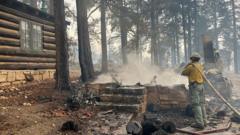What Happened to the Historic Lodge Lost in the Grand Canyon Fire?

Understanding the Impact of Wildfires at the Grand Canyon
The Grand Canyon, a UNESCO World Heritage Site and one of the Seven Natural Wonders of the World, has recently faced devastating wildfires that have altered its landscape and impacted its visitors. In 2025, the raging Dragon Bravo Fire and White Sage Fire have wreaked havoc, destroying dozens of buildings, including the historic Grand Canyon Lodge. This article delves into the causes, effects, and ongoing efforts related to these wildfires, providing a comprehensive overview of the situation.
Overview of the Wildfires
As of now, the Dragon Bravo Fire and White Sage Fire have collectively consumed tens of thousands of acres within the Grand Canyon region. The fires were ignited by natural causes, specifically lightning strikes, which are a common catalyst for wildfires in the arid landscapes of Arizona.
The Dragon Bravo Fire
One of the most devastating blazes, the Dragon Bravo Fire, has been responsible for the destruction of approximately 50 to 80 buildings, including essential administrative and visitor facilities. Most notably, it claimed the Grand Canyon Lodge, which had been a vital accommodation for tourists since the 1930s. The lodge served as a central hub for visitors, offering dining facilities, a gift shop, and a post office, making its loss particularly significant.
The White Sage Fire
In parallel, the White Sage Fire has burned over 40,000 acres of the Kaibab National Forest, leading to the evacuation of hundreds of residents and tourists. Both fires have been fueled by strong winds, which reached speeds of up to 40 mph, exacerbating the spread of the flames and complicating firefighting efforts.
The Evacuation and Safety Measures
As a precautionary measure, authorities have evacuated numerous visitors and staff members from the affected areas. Thankfully, no injuries have been reported due to the swift action taken by the National Park Service and local agencies. Their focus has been on ensuring the safety of all individuals in the vicinity of the wildfires.
Chlorine Leak Incident
Compounding the challenges faced by firefighters was a chlorine leak from a nearby water treatment facility. Chlorine gas, being denser than air, poses a significant risk to both firefighters and hikers, especially in lower elevations. This incident necessitated quick evacuations and added another layer of complexity to managing the fire situation.
Impact on Tourism and Local Community
The Grand Canyon is one of the most visited national parks in the United States, attracting nearly five million visitors in 2024 alone. The closure of the North Rim due to the ongoing fires will undoubtedly have a lasting impact on tourism and the local economy.
Closure of the North Rim
With the North Rim closed for the remainder of the 2025 tourist season, many travelers will be left without access to this unique part of the park, which offers breathtaking views and a more secluded experience compared to the more populated South Rim. This closure not only affects tourists but also local businesses that rely heavily on the influx of visitors during peak seasons.
Firefighting Efforts and Challenges
Firefighting crews have been working tirelessly to contain the wildfires. Their efforts have been complicated by the unpredictable weather conditions and the rugged terrain of the Grand Canyon region. Firefighters employ various strategies, including creating firebreaks and conducting controlled burns in certain areas to prevent the further spread of flames.
The Role of Technology in Fire Management
Modern firefighting strategies increasingly rely on technology, including drones and satellite imagery, to monitor fire spread and assess damages. These tools allow for more informed decision-making and efficient allocation of resources. Moreover, ground crews are augmented by aerial support, which drops water and fire retardants to help contain blazes.
Long-Term Consequences of Wildfires
Wildfires can have long-lasting effects on ecosystems, wildlife, and the health of the environment. The Grand Canyon, known for its rich biodiversity, may see shifts in habitats and species distribution as a result of these fires.
Ecological Impact
While some species are adapted to survive wildfires, the scale of the current blazes raises concerns about the long-term ecological balance. The fires may lead to soil erosion, loss of vegetation, and alterations to water quality in nearby streams and rivers.
Restoration and Recovery Efforts
In the aftermath of the fires, restoration efforts will be vital. The National Park Service and various environmental organizations will need to assess the damage and implement recovery plans to restore the affected areas. This may include replanting native vegetation, monitoring wildlife populations, and ensuring that the park continues to thrive as a natural habitat.
Conclusion: A Call to Action
The recent wildfires near the Grand Canyon serve as a stark reminder of the challenges posed by climate change and the importance of proactive environmental stewardship. As we witness the devastation of natural wonders, it becomes crucial to support conservation efforts and raise awareness about the impacts of wildfires.
Whether you are a frequent visitor to national parks or simply a nature enthusiast, consider how you can contribute to preserving these natural treasures. From supporting local conservation groups to practicing responsible outdoor habits, every effort counts.
FAQs About the Grand Canyon Wildfires
What are the main causes of wildfires in the Grand Canyon area?
The primary causes of wildfires in the Grand Canyon region are natural events, such as lightning strikes, combined with factors like dry conditions and strong winds.
Is the South Rim of the Grand Canyon still open to visitors?
Yes, as of now, the South Rim remains open to visitors, providing access to many of the park's iconic viewpoints and trails.
What safety measures are in place for visitors during wildfire season?
During wildfire season, the National Park Service implements various safety measures, including monitoring fire conditions, providing alerts to visitors, and conducting evacuations when necessary.
As the Grand Canyon faces the aftermath of these wildfires, it's essential to reflect on our role in protecting such vital landscapes. What can you do to help preserve the beauty of the Grand Canyon for future generations? #GrandCanyon #WildfireAwareness #ConservationEfforts
Published: 2025-07-14 10:00:18 | Category: wales



